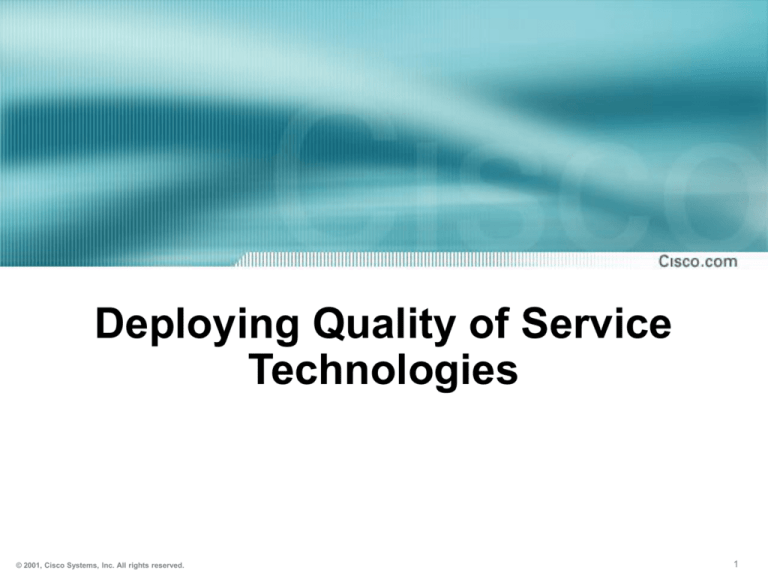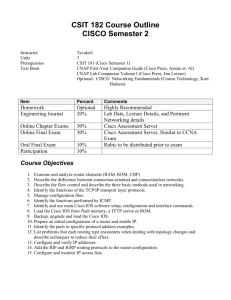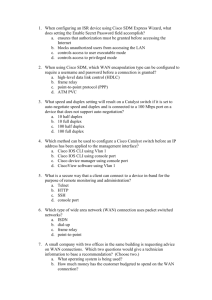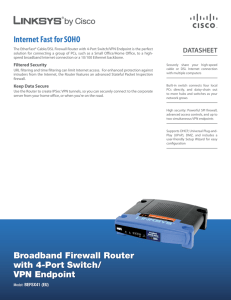
Deploying Quality of Service
Technologies
© 2001, Cisco Systems, Inc. All rights reserved.
1
Agenda
•
•
•
•
•
© 2001, Cisco Systems, Inc. All rights reserved.
QoS Metrics
QoS Architectures
QoS Design Guidelines
A QoS Scenario
Summary
2
QoS Metrics
What are we trying to control?
• Four metrics are used to describe a packet’s
transmission through a network – Bandwidth,
Delay, Jitter, and Loss
• Using a pipe analogy, then for each packet:
Bandwidth is the perceived width of the pipe
Delay is the perceived length of the pipe
Jitter is the perceived variation in the length of the pipe
Bandwidth
Loss is the perceived leakiness if the pipe
A
© 2001, Cisco Systems, Inc. All rights reserved.
The path as perceived by a packet!
B
Delay
3
QoS Metrics – Bandwidth
The amount of bandwidth available to a packet
is affected by:
The slowest link found in the transmission path
The amount of congestion experienced at each hop –
TCP slow-start and windowing
The forwarding speed of the devices in the path
The queuing priority given to the packet flow
100 Mb/s
2Mb/s
10 Mb/s
2 Mb/s Maximum Bandwidth
© 2001, Cisco Systems, Inc. All rights reserved.
4
QoS Metrics – Delay
The amount of delay experienced by a packet is
the sum of the:
Fixed Propagation Delays
Bounded by the speed of light and the path distance
Fixed Serialization Delays
The time required to physically place a packet onto a
transmission medium
Variable Switching Delays
The time required by each forwarding engine to resolve the
next-hop address and egress interface for a packet
Variable Queuing Delays
The time required by each switching engine to queue a packet
for transmission
© 2001, Cisco Systems, Inc. All rights reserved.
5
QoS Metrics – Jitter
The amount of Jitter experienced by a packet is
affected by:
~214ms Serialization
Serialization delays on low-speed interfaces
Delay for a 1500-byte
packet at 56Kb/s
Variations in queue-depth due to congestion
Variations in queue cycle-times induced by the service
architectures – First-Come, First-Served, for example
60B every 20ms
Voice
1500 Bytes of Data Voice
60B every 214ms
Voice
1500 Bytes of Data Voice
10 Mbps Ethernet
60B every 214ms
Voice
1500 Bytes of Data Voice
10 Mbps Ethernet
56 Kbps WAN
© 2001, Cisco Systems, Inc. All rights reserved.
6
QoS Metrics – Loss
The amount of loss experienced by a packet
flow is affected by:
Buffer exhaustion due to congestion caused by
oversubscription or rate-decoupling
Intentional packet drops due to congestion control
mechanism such as Random Early Discard
DS-3
GE
GE
Oversubscribed
© 2001, Cisco Systems, Inc. All rights reserved.
GE
Buffer Exhaustion
7
QoS Architectures
© 2001, Cisco Systems, Inc. All rights reserved.
8
QoS Implementation Models
No State
Aggregated State
Per-Flow State
1. Best Effort
2. IntServ/RSVP
3. DiffServ
4. RSVP+DiffServ+MPLS
© 2001, Cisco Systems, Inc. All rights reserved.
9
Integrated Services (IntServ)
The Integrated Services (IntServ) model builds upon
Resource Reservation Protocol (RSVP)
Reservations are made per simplex flow
Applications request reservations for network resources
which are granted or denied based on resource availability
Senders specify the resource requirements via a PATH
message that is routed to the receiver
Receivers reserve the resources with a RESV message that
follows the reverse path
RESV
Sender
Receiver
PATH
© 2001, Cisco Systems, Inc. All rights reserved.
10
IntServ – Components
The Integrated Services Model can be divided
into two parts – the Control and Data Planes
Control Plane
Routing Selection
Admission Control
Reservation Setup
Reservation Table
Data Plane
Flow Identification
© 2001, Cisco Systems, Inc. All rights reserved.
Packet Scheduler
11
IntServ – Components
Control Plane
Route Selection – Identifies the route to follow for the
reservation (typically provided by the IGP processes)
Reservation Setup – Installs the reservation state along the
selected path
Admission Control – Ensures that resources are available
before allowing a reservation
Data Plane
Flow Identification – Identifies the packets that belong to a
given reservation (using the packet’s 5-Tuple)
Packet Scheduling – Enforces the reservations by queuing
and scheduling packets for transmission
© 2001, Cisco Systems, Inc. All rights reserved.
12
IntServ – Service Models
Applications using IntServ can request two
basic service-types:
Guaranteed Service
Provides guaranteed bandwidth and queuing delays end-toend, similar to a virtual-circuit
Applications can expect hard-bounded bandwidth and delay
Controlled-Load Service
Provides a Better-than-Best-Effort service, similar to a
lightly-loaded network of the required bandwidth
Applications can expect little to zero packet loss, and little to
zero queuing delay
These services are mapped into policies that are
applied via CB-WFQ, LLQ, or MDRR
© 2001, Cisco Systems, Inc. All rights reserved.
13
IntServ – Scaling Issues
IntServ routers need to examine every packet to
identify and classify the microflows using the 5-tuple
IntServ routers must maintain a token-bucket per
microflow
Guaranteed Service requires the creation of a queue
for each microflow
Data structures must be created and maintained for
each reservation
© 2001, Cisco Systems, Inc. All rights reserved.
14
Differentiated Services (DiffServ)
The DiffServ Model specifies an approach that offers a
service better than Best-Effort and more scalable than
IntServ
Traffic is classified into one of five forwarding classes
at the edge of a DiffServ network
Forwarding classes are encoded in the Differentiated
Services Codepoint (DSCP) field of each packet’s IP
header
DiffServ routers apply pre-provisioned Per-Hop
Behaviors (PHBs) to packets according to the encoded
forwarding class
5
© 2001, Cisco Systems, Inc. All rights reserved.
4
3
2
1
5
4
3
2
1
15
DiffServ – Compared to IntServ
DiffServ allocates resources to aggregated rather than
to individual flows
DiffServ moves the classification, policing, and
marking functions to the boundary nodes – the core
simply forwards based on aggregate class
DiffServ defines Per-Hop forwarding behaviors, not
end-to-end services
DiffServ guarantees are based on provisioning, not
reservations
The DiffServ focus is on individual domains, rather
than end-to-end deployments
© 2001, Cisco Systems, Inc. All rights reserved.
16
DiffSrv – The DS Field (RFC 2474)
DS field
DSCP
CU
The DS field is composed of the 6 high-order bits of
the IP ToS field
The DS field is functionally similar to the IPv4 TOS
and IPv6 Traffic Class fields
The DS field is divided into three pools:
nnnnn0 – Standards Use
nnnn11 – Experimental / Local Use
nnnn01 – Experimental / Local Use, possible Standards Use
Class Selector Codepoints occupy the high-order
bits (nnn000) and map to the IPv4 Precedence bits
© 2001, Cisco Systems, Inc. All rights reserved.
17
DiffSrv – Forwarding Classes
The DS Field can encode:
Eight Class Selector Codepoints
compatible with legacy systems (CS0-7)
An Expedited Forwarding (EF) Class
Four Assured Forwarding Classes, each
with three Drop Precedence (AFxy, where
x=1-4, and y=1-3)
Packets in a higher AF Classes have a
higher transmit priority
Packets with a higher Drop Precedence are
more likely to be dropped
© 2001, Cisco Systems, Inc. All rights reserved.
DSCP
Codepoint
000000
CS0 (DE)
001000
CS1
001010
AF11
001100
AF12
001110
AF13
010000
CS2
010010
AF21
010100
AF22
010110
AF23
011000
CS3
011010
AF31
011100
AF32
011110
AF33
100000
CS4
100010
AF41
100100
AF42
100110
AF43
101000
CS5
101110
EF
110000
CS6
111000
CS7
18
DiffServ – Per-Hop Behaviours
A Per-Hop Behaviour (PHB) is an observable forwarding
behaviour of a DS node applied to all packets with the
same DSCP
PHBs do NOT mandate any specific implementation
mechanisms
The EF PHB should provide a low-loss, low-delay, lowjitter, assured bandwidth service
The AF PHBs should provide increasing levels or
service (higher bandwidth) for increasing AF levels
The Default PHB (CS0) should be equivalent to BestEffort Service
Packets within a given PHB should not be re-ordered
© 2001, Cisco Systems, Inc. All rights reserved.
19
DiffServ – Boundary Nodes
DiffServ Boundary Nodes are responsible for classifying
and conditioning packets as they enter a given DiffServ
Domain
Conditioning
Remarker
Classification
Classifier
Marker
Meter
Shaper
Dropper
Classifier
Marker
Meter
Remarker
Shaper
Dropper
© 2001, Cisco Systems, Inc. All rights reserved.
Examine each packet and assign a Forwarding Class
Set the DS Field to match the Forwarding Class
Measure the traffic flow and compare it to the traffic profile
Remark (lower) the DS Field for out-of-profile traffic
Shape the traffic to match the traffic profile
Drop out of profile traffic
20
DiffServ – Summary
DiffServ Domain
Classification / Conditioning
PHB
LLQ/WRED
Premium Gold
© 2001, Cisco Systems, Inc. All rights reserved.
Silver Bronze
21
The Trouble with DiffServ
As currently formulated, DiffServ is strong on
simplicity and weak on guarantees
Virtual wire using EF is OK, but how much
can be deployed?
DiffServ has no topology-aware admission
control mechanism
© 2001, Cisco Systems, Inc. All rights reserved.
22
RSVP-DiffServ Integration
The best of both worlds – Aggregated RSVP
integrated with DiffServ
No State
Aggregated
State
Per-Flow State
RSVP + DiffServ
Best Effort
DiffServ
Aggregated State
Firm Guarantees
Admission Control
IntServ
But – given the presence of a DiffServ
domain in a network, how do we support
RSVP End-to-End?
© 2001, Cisco Systems, Inc. All rights reserved.
23
RSVP-DiffServ Integration – How?
Routers at edge of a DS cloud perform microflow
classification, policing, and marking
• Guaranteed Load set to the EF, Controlled load set to AFx, and
Best Effort set to CS0
• Service Model to Forwarding Class mapping is arbitrary
RSVP signaling is used in both the IntServ and
DiffServ regions for admission control
The DiffServ core makes and manages aggregate
reservations for the DS Forwarding Classes based on
the RSVP microflow reservations
The core then schedules and forwards packets based
only on the DS Field
© 2001, Cisco Systems, Inc. All rights reserved.
24
RSVP-DiffServ Integration
Border Routers implement per-flow
classification, policing, and marking
The DiffServ region
aggregates the flows into
DS Forwarding Classes
DiffServ Region
RSVP Signaling is propagated
End-to End
The IntServ regions contain
Guaranteed or Controlled
Load Microflows
© 2001, Cisco Systems, Inc. All rights reserved.
25
RSVP-DiffServ Integration – Summary
The forwarding plane is still DiffServ
We now make a small number of aggregated
reservations from ingress to egress
Microflow RSVP messages are carried across the
DiffServ cloud
Aggregate reservations are dynamically adjusted to
cover all microflows
RSVP flow-classifiers and per-flow queues are
eliminated in the core
Scalability is improved – only the RSVP flow states
are necessary – Tested to 10K flows
© 2001, Cisco Systems, Inc. All rights reserved.
26
MPLS Traffic Engineering – A Summary
Uses Constraint-based routing for path
selection – IS-IS or CSPF
MPLS tunnels are setup via RSVP
Utilizes DiffServ-aware forwarding based on
MPLS EXP bits
Traffic can be managed based on both
bandwidth or administrative metrics
© 2001, Cisco Systems, Inc. All rights reserved.
27
QoS Design Guidelines
© 2001, Cisco Systems, Inc. All rights reserved.
28
QoS Design Guidelines
1. Investigate and understand application
requirements and behaviors
2. Group applications or users together based
on their QoS needs – bandwidth, latency,
jitter, and packet loss
3. Use the proper QoS tools at the correct
places in the network to meet the needs of
these groups
© 2001, Cisco Systems, Inc. All rights reserved.
29
QoS Requirements for Applications
Voice
FTP
ERP and
MissionCritical
Low to
Moderate
Moderate
to High
Varies
Loss Sensitivity
Low
High
Moderate
to High
Delay Sensitive
High
Low
Low to
Moderate
Jitter Sensitive
High
Low
Varies
Bandwidth
Traffic should be grouped into classes
that have similar QoS requirements
© 2001, Cisco Systems, Inc. All rights reserved.
30
The Cisco QoS Architecture
Classification
Queuing
Policing
Marking
Identify and Split
Traffic into
Different Classes
Discard Misbehaving
Traffic to
Maintain Network
Integrity
© 2001, Cisco Systems, Inc. All rights reserved.
Mark Traffic
According to
Behavior and
Business
Policies
Prioritize,
Protect and
Isolate Traffic
Based on
Markings
Shaping
Control Bursts
and Conform
Traffic
31
Classification – Defining a Class
Applications
Single users
• MAC address
• IP address
• TCP/UDP Port number
• 5-Tuples
• URLs
Departments, customers
• IP Subnet
• Ingress Interface
Traffic Classes are usually mapped to the IP Precedence
or DiffServ DS Fields to control Queuing and Congestion
Management Routines
© 2001, Cisco Systems, Inc. All rights reserved.
32
Classification – NBAR
My Application
Is too Slow!
Network Based Application Recognition
(NBAR) can:
Analyze application traffic patterns in real
time
Classify packets based on:
• L4-L7 protocols which dynamically assign
TCP/UDP ports
• HTTP Traffic by URL or MIME
Provides per-interface, per-protocol, bidirectional statistics
Link Utilization
Citrix
Netshow
Oracle
FTP
HTTP
25%
15%
10%
30%
20%
© 2001, Cisco Systems, Inc. All rights reserved.
Mark Citrix Real-Time as
GOLD Service and Police FTP
Guarantee Bandwidth for Citrix!
33
Classification – Rules
Classify Packets as close to the network edge as
possible
Classify locally generated voice packets using ‘dialpeer’ commands
Use Class-Maps or Network-Based Application
Recognition (NBAR) to classify packets
Avoid Host-Based Packet Marking
VolP
HTTP
FTP
Separate “Conform” and
“Exceed” Actions
© 2001, Cisco Systems, Inc. All rights reserved.
VolP
HTTP
FTP
VolP Platinum Class
HTTP Gold Class
FTP Bronze Class
34
Classification – Configuration
Router(config)# class-map Gold
Router(config-cmap )# match ip rtp 16384 17383
Router(config-cmap)# exit
Router(config)# class-map Silver
Router(config-cmap)# match protocol Citrix
Router(config-cmap)# exit
© 2001, Cisco Systems, Inc. All rights reserved.
35
Policing – Monitoring Service Levels
Policing is used to compare packet arrival
rates to provisioned service agreements
Policers identify flows as either conforming,
exceeding, or violating the service agreement
Different actions can be taken for conforming,
exceeding, and violating packets
Two types of Policers are available:
• RFC 2697: A Single-Rate, Three-Color Marker
• RFC 2698: A Dual-Rate, Three-Color Marker
© 2001, Cisco Systems, Inc. All rights reserved.
36
Policing – Monitoring Service Levels
Conform / Exceed / Violate Actions
• drop
• set-dscp-transmit
• set-mpls-exp-transmit
• set-prec-transmit
• set-clp-transmit
• set-de-transmit
• set-qos-transmit
• transmit
© 2001, Cisco Systems, Inc. All rights reserved.
37
Policing – Single-Rate, Three-Color Marker
Usage:
• Mark conforming traffic with a low drop precedence
• Mark exceeding traffic with a high drop precedence
• Drop violating traffic
Definitions:
•
•
•
•
•
CIR – Committed Information Rate
CBS – Committed Burst Size (max)
EBS – Excess Burst Size (max)
Tc – Current size of CBS bucket
Te – Current size of EBS bucket
© 2001, Cisco Systems, Inc. All rights reserved.
38
Policing – Single-Rate, Three-Color Marker
© 2001, Cisco Systems, Inc. All rights reserved.
39
Policing – Configuration (SRTC)
Router(config)# policy-map access-in
Router(config-pmap)# class Silver
Router(config-pmap-c)# police bps burstnormal burst-max conform-action action
exceed-action action violate-action action
Router(config-pmap)# exit
© 2001, Cisco Systems, Inc. All rights reserved.
40
Policing – Two-Rate, Three-Color Marker
Usage:
• Mark packets within CIR as conforming
• Mark packets between CIR and PIR as exceeding
• Drop packets above the PIR
Definitions:
•
•
•
•
•
•
CIR – Committed Rate
PIR – Peak rate
CBS – Committed burst size (max)
PBS – Peak burst size (max)
Tc – Current size of CBS bucket
Tp – Current size of PBS bucket
© 2001, Cisco Systems, Inc. All rights reserved.
41
Policing – Two-Rate, Three-Color Marker
© 2001, Cisco Systems, Inc. All rights reserved.
42
Policing – Configuration (TRTC)
Router(config)# policy-map access-in
Router(config-pmap)# class Silver
Router(config-pmap-c)# police cir cir bc
burst-normal pir bps be burst-max
conform-action action exceed-action action
violate-action action
Router(config-pmap)# exit
© 2001, Cisco Systems, Inc. All rights reserved.
43
Marking – Marker Locations and Size
Type of Marking
# of
Bits
Bits Location
IP Precedence
3
Three most significant bits of TOS byte
in IPv4 and IPv6 headers
Differentiated
Services Code
Point (DSCP)
6
Six most significant bits of TOS byte in
IPv4 and IPv6 headers
MPLS
Experimental
(EXP) Bits
3
Part of 20 bit MPLS label
Ethernet CoS Bits
3
ISL or 802.1q/p header
ATM CLP Bit
1
ATM Cell header
Frame Relay DE Bit
1
Frame Relay header
© 2001, Cisco Systems, Inc. All rights reserved.
44
Marking – Configuration
Router(config)# policy-map access-in
Router(config-pmap)# class Silver
Router(config-pmap-c)# set ip dscp 26
Router(config-pmap)# exit
© 2001, Cisco Systems, Inc. All rights reserved.
45
Queueing / Scheduling
Determines the placement of packets in
Queues and the Queue Servicing algorithms
Class-Based Weighted Fair Queuing (CBWFQ) makes the scheduler aware traffic
classes instead of just traffic flows
Low Latency Queuing (LLQ) adds a priority
queue to Class-Based Weighted Fair Queuing
When there is no congestion the schedular
uses First-In-First-Out (FIFO)
© 2001, Cisco Systems, Inc. All rights reserved.
46
Queuing / Scheduling – CBWFQ
Gold
40%
High Bandwidth, Low-Delay
Silver
25%
Bounded Bandwidth and Delay
Bronze
10%
Best Effort
Step 1: Define Classes
Step 2: Define Bandwidth
Queue weights are assigned to traffic classes instead
of flows
Class definitions allow the specification of minimum
bandwidth
Unused capacity in one class is made available to
traffic in other classes
Queues can be configured differently for each class
© 2001, Cisco Systems, Inc. All rights reserved.
47
Queuing / Scheduling – LLQ
V V
1 1
Priority Class
Class 1
Class 2
2
3
3
3
2
Interface
PQ
4
3
2
V V
1 1
3
WFQ
Class 3
Class-Default
4
4
4
4
7
6
5
LLQ adds a guaranteed priority queue to CB-WFQ
Allows strict priority queuing to be applied to any
traffic class, not just RTP/UDP (IP RTP Priority)
Bandwidth assigned to the priority queue is not
shared with other classes
© 2001, Cisco Systems, Inc. All rights reserved.
48
Queuing / Scheduling – Configuration
Router(config)# policy-map wan_policy
Router(config-pmap)# class Gold
Router(config-pmap-c)# priority 128
Router(config-pmap)# exit
Router(config-pmap)# class Silver
Router(config-pmap-c)# bandwidth 256
Router(config-pmap)# exit
Router(config-pmap)class class-default
Router(config-pmap-c)# fair-queue
© 2001, Cisco Systems, Inc. All rights reserved.
49
Queuing / Scheduling – Configuration
Absolute Percent Specifications for LLQ
policy-map Multiservice
class VoIP
priority percent 10 (OR prior
class business
bandwidth percent 30
class data
bandwidth percent 20
Relative Percent Specifications for LLQ
policy-map Multiservice
class VoIP
priority percent 10
class business
bandwidth remaining percent 80
class class-default
bandwidth remaining percent 20
© 2001, Cisco Systems, Inc. All rights reserved.
50
Shaping – Class-Based Generic
Router(config)# policy-map access-out
Router(config-pmap)# class Silver
Router(config-pmap-c)# shape {average | peak} cir bc be
Router(config-pmap)# exit
© 2001, Cisco Systems, Inc. All rights reserved.
51
Shaping – Class-Based Frame-Relay
Router(config)# interface serial 0
Router(config-if)# frame-relay traffic-shaping
Router(config-if)# interface s0.1 point-to-point
Router(config-subif)# frame-relay interface-dlci 100
Router(config-fr-dlci)# class frts
Router(config)# map-class frame-relay frts
Router(config-map-class)# frame-relay cir 56000
Router(config-map-class)# frame-relay bc 560
Router(config-map-class)# frame-relay be 0
Router(config-map-class)# frame-relay mincir 56000
Router(config-map-class)# no frame-relay adaptive-shaping
© 2001, Cisco Systems, Inc. All rights reserved.
52
Congestion Avoidance
If a queue becomes full, all of the packets
that overflow the queue get dropped – TailDrop
Tail-Drops cause the TCP congestion control
algorithms to activate on a large number of
sessions, causing global synchronization
A mechanism is needed to prevent queue
exhaustion, thereby preventing global
synchronization
© 2001, Cisco Systems, Inc. All rights reserved.
53
TCP Slow Start / Congestion Control
45
40
35
Congestion Avoidance Phase
Linear Growth
30
25
20
15
10
5
Slow Start
Exponential Growth
0
20
© 2001, Cisco Systems, Inc. All rights reserved.
50
54
Congestion Avoidance: The Problem
Queue
Utilization
100%
Time
Tail Drop
3 Traffic Flows Start
at Different Times
© 2001, Cisco Systems, Inc. All rights reserved.
Another Traffic Flow
Starts at this Point
55
Weighted Random Early Detect (WRED)
Drop
Probability
1
1/m
0
Min 1
Min 2
Min 3
Max 1 Max 2 Max 3
Average Queue Depth
© 2001, Cisco Systems, Inc. All rights reserved.
Max Queue
Length(Tail Drop)
56
WRED Configuration
Router(config)# policy-map wan_policy
Router(config-pmap)# class Silver
Router(config-pmap-c)# bandwidth percent 20
Router(config-pmap-c)# random-detect dscp-based
Router(config-pmap-c)# random-detect dscp
dscpvalue min-threshold max-threshold (markprobability-denominator)
Router(config-pmap)# exit
© 2001, Cisco Systems, Inc. All rights reserved.
57
Configuring QoS in IOS
MQC Abstractions and Syntax
class-map [match-any | match-all] class-name
Enters configuration sub-mode for class definition
policy-map policy-name
Enters configuration sub-mode for policy definition
(marking, policing, shaping, queuing, etc.)
service-policy {input | output} policy-name
Command in interface configuration sub-mode to
apply QoS policy for input or output traffic
© 2001, Cisco Systems, Inc. All rights reserved.
58
A University QoS Scenario
© 2001, Cisco Systems, Inc. All rights reserved.
59
University Scenario – Requirements
Guarantee 512 Kb/s to multicast traffic across
my campus
• Application is video-on-demand – requires
guaranteed bandwidth, low loss, bounded delay
and jitter
• Guaranteed priority service is not necessary
Limit Napster to 10% of my internet link (T1)
© 2001, Cisco Systems, Inc. All rights reserved.
60
University Scenario—Topology
GW
RP
Source
T1
Traffic Flow
Internet
Receiver
© 2001, Cisco Systems, Inc. All rights reserved.
61
University Scenario – Design
Use policy-based routing or class-based marking
to mark IP precedence bits for multicast traffic as
close to source as possible
Use class-based weighted fair queuing (CBWFQ)
to guarantee bandwidth
Use NBAR to recognize Napster and then traffic
policing to limit it to 10% of the T1 Internet link
© 2001, Cisco Systems, Inc. All rights reserved.
62
University Scenario – Configuration
On the router closest to the source:
Router(config)# class-map ipmc
Router(config-cmap)# match access-group 100
Router(config)# policy-map markipmc
Router(config-pmap)# class ipmc
Router(config-pmap-c)# set ip precedence 4
Router(config)# interface ethernet0/0
Router(config-if)# service-policy input markipmc
Router(config-if)#
Router(config)# access-list 100 permit udp any 224.0.0.0 31.255.255.255
© 2001, Cisco Systems, Inc. All rights reserved.
63
University Scenario – Configuration
Queuing configuration multicast-tree routers:
Router(config)# class-map multicast
Router(config-cmap)# match ip precedence 4
Router(config)# policy-map univq
Router(config-pmap)# class multicast
Router(config-pmap-c)# bandwidth 512
Router(config-pmap-c)# !
Router(config)# interface ethernet0/0
Router(config-if)# service-policy output univq
© 2001, Cisco Systems, Inc. All rights reserved.
64
University Scenario – Configuration
On the Gateway (GW) Router:
Router(config)# class-map Napster
Router(config-cmap)# match protocol napster
Router(config)# policy-map limitnapster
Router(config-pmap)# class Napster
Router(config-pmap-c)# police 153600
Router(config)# interface serial0
Router(config)# bandwidth 1536
Router(config-if)# service-policy input limitnapster
Router(config-if)# service-policy output limitnapster
© 2001, Cisco Systems, Inc. All rights reserved.
65
Useful Information
• CCO QoS page
http://www.cisco.com/go/qos
• Cisco IOS 12.2 QoS documentation
• “IP Quality of Service” book
http://www.ciscopress.com/book.cfm?series=1&book=173
© 2001, Cisco Systems, Inc. All rights reserved.
66
Session IPS–230
2881_05_2001
© 2001, Cisco Systems, Inc. All rights reserved.
67







